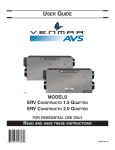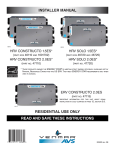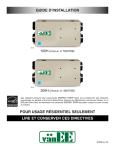Download Venmar HRV CONSTRUCTO 2.0ES User manual
Transcript
USER MANUAL RESIDENTIAL USE ONLY VB0175 HRV CONSTRUCTO 2.0ES* HRV CONSTRUCTO 1.5ES* * THESE PRODUCTS EARNED THE ENERGY STAR® BY MEETING STRICT ENERGY EFFICIENCY GUIDELINES SET BY NATURAL RESOURCES CANADA AND THE US EPA. THEY MEET ENERGY STAR REQUIREMENTS ONLY WHEN USED IN CANADA. VB0170 ERV CONSTRUCTO 2.0ES ADDRESS OF YOUR INSTALLER 20505 REV. 03 ABOUT THIS MANUAL / PRODUCT The purpose of this manual is to help you with the use of your unit. Section 2 (Controls) shows you how you can operate the unit in no time. Section 3 deals with maintenance and explains how to maintain the unit to ensure maximum operation and performance. In Section 4 (Troubleshooting), you will learn how to solve minor problems; plus other important information which we urge you to read. We welcome any suggestions you may have concerning this manual and/or the unit, and we would appreciate hearing your comments on ways to better serve you. Please forward all correspondence to us at the address indicated on the product’s registration card included with this manual. This manual uses the following symbols to emphasize particular information: ! WARNING Identifies an instruction which, if not followed, might cause serious personal injuries including possibility of death. CAUTION Denotes an instruction which, if not followed, may severely damage the unit and/or its components. NOTE: Indicates supplementary information needed to fully complete an instruction. Finally, we want to congratulate you on your purchase of this excellent unit which will allow you and your family to enjoy fresh air throughout your home for years to come! CAUTION Some activities create dust or vapors which may damage your unit. You must therefore turn off and unplug your unit in the following situations: • Major renovation work • Sanding (e.g. gypsum joints, etc.) • Housing construction • Varnishing During very heavy snowstorms or rain with strong winds, the unit should also be turned off to avoid problems caused by snow or rain entering the unit, even if it is equipped with an anti-gust intake hood. Power disturbances or very short power failures may cause the electronic control microprocessor to malfunction. If it does, disconnect the power plug from the outlet and wait approximately 30 seconds, then plug it back in to resume operation. CAUTION When leaving the house for a long period of time (more than two weeks), a responsible person should regularly check if the unit operates adequately. If the ductwork runs through an unconditioned space (e.g.: attic), the unit must operate continuously except when performing maintenance and/or repair. Also, the ambient temperature of the house should never drop below 18°C (65°F). At least once a year, the unit mechanical and electronic parts should be inspected by qualified service personnel. 2 TABLE OF CONTENTS 1. YOUR UNIT AND ITS PURPOSE ........................................... 4-6 1.1 UNIT DESCRIPTION . . ...................................... ..............................4 1.2 PURPOSE OF THE VENTILATION SYSTEM ..................................................4 1.3 RECOVERY . . . . . . . . . . . ...................................................................5 1.3.1 HEAT RECOVERY CORE . . . . . . . . . . . . . . . . . . . . . . . . . . . . . . . . . . . . . . . . . . . . . . . . . . . . . . . . . . . . . . . . . . . . . 5 1.3.2 ENERGY RECOVERY CORE . . . . . . . . . . . . . . . . . . . . . . . . . . . . . . . . . . . . . . . . . . . . . . . . . . . . . . . . . . . . . . . . . . 5 1.4 DEFROST MODE . . . . . . ..................................... ..............................6 1.5 SPECIFICATIONS . . . . . . ...................................................................6 2. CONTROLS ..................................................................... 7 2.1 INTEGRATED CONTROL ...................................................................7 2.2 BOOT SEQUENCE . . . . . ..................................... ..............................7 2.3 OPTIONAL MAIN AND AUXILIARY CONTROLS ...............................................7 3. MAINTENANCE .............................................................. 8-9 3.1 EVERY THREE MONTHS .................................... ..............................8 3.2 ANNUAL MAINTENANCE (FALL) ............................................................9 3.2.1 HEAT RECOVERY CORE . . . . . . . . . . . . . . . . . . . . . . . . . . . . . . . . . . . . . . . . . . . . . . . . . . . . . . . . . . . . . . . . . . . . . 9 3.2.2 ENERGY RECOVERY CORE . . . . . . . . . . . . . . . . . . . . . . . . . . . . . . . . . . . . . . . . . . . . . . . . . . . . . . . . . . . . . . . . . . 9 4. TROUBLESHOOTING ....................................................... 10 3 1. YOUR UNIT AND ITS PURPOSE 1.1 UNIT DESCRIPTION 1 1. 2. 3. 4. Filters Blower Recovery core Condensation tray 1 3 2 4 VL0052 1.2 PURPOSE OF THE VENTILATION SYSTEM Your ventilation system is designed to provide fresh air, warmed outdoor air to your home while exhausting stale, humid air from your home. By eliminating accumulated pollutants and humidity, it maintains an optimum air quality and an ideal relative humidity. VH0078 NOTES: 1. Shown with a forced air system. Can also operate on its own. 2. Installation may vary according to the model number. 4 1. YOUR UNIT AND ITS PURPOSE (CONT’D) 1.3 RECOVERY 1.3.1 HEAT RECOVERY CORE Units with a heat recovery core (HRV Constructo 1.5ES and HRV Constructo 2.0ES units) are designed specifically to control excess humidity and reduce ventilation costs by recovering the heat energy from the exhausted air, and using that same heat energy to warm the fresh air being supplied. This heat recovery process is accomplished in such a way that the stale air is never mixed with the fresh air. EXAMPLE (IN WINTER) Stale air to outdoors Fresh air to building 16°C/61°F Fresh air from outdoors Stale air from building INDOOR OUTDOORS 6°C/42°F 0°C/32°F 22°C/72°F VF0026 1.3.2 ENERGY RECOVERY CORE The ERV Constructo 2.0ES unit is equipped with an energy recovery core (enthalpic core) that can reduce ventilation costs in winter as well as in summer. 1. During heating season, the unit draws humidity and heat from the stale air and transfers them, in part, to the cold air entering the house, thus avoiding dryness problems and providing maximum comfort (Example 1). 2. During cooling season, the unit reverses the process, preventing humidity from the outdoor air from entering the house (Example 2). Stale air to outdoors Fresh air to building EXAMPLE 2 (IN SUMMER WITH AIR CONDITIONING) Stale air Fresh air to outdoors to building 4°C/40°F 18°C/64°F 30°C/86°F EXAMPLE 1 (IN WINTER) VF0042 27°C/80°F VF0043 0°C/32°F 22°C/72°F 32°C/90°F 25°C/77°F Fresh air from outdoors Stale air from building Fresh air from outdoors Stale air from building 5 1. YOUR UNIT AND ITS PURPOSE (CONT’D) 1.4 DEFROST MODE When the outdoor temperature is below -5°C (23°F), recovery (of heat or energy) creates frost in the module. To maintain its proper operation, the unit is programmed to defrost the recovery module. The defrost frequency varies according to the outdoor temperature. Defrost lasts 7 minutes for HRV Constructo 1.5ES, 6 minutes for HRV Constructo 2.0ES and 10 minutes for ERV Constructo 2.0ES models (or 10 minutes for all models if set on “Extented Defrost”). During the defrost cycle, the unit shifts to maximum speed and the dampers close. After defrosting, the unit returns to the operating mode selected by the user. 1.5 SPECIFICATIONS MODEL HRV CONSTRUCTO 1.5ES HRV CONSTRUCTO 2.0ES WIDTH 30¼" 30¼" 34" HEIGHT 16½" 16½" 16½" DEPTH 171∕8" 171∕8" WEIGHT 65 LB. (29.5 KG) 65 LB. (29.5 KG) ELECTRICAL SUPPLY 120 V, 60 HZ 120 V, 60 HZ POWER CONSUMPTION 160 WATTS 195 WATTS 6 ERV CONSTRUCTO 2.0ES 171∕8" 76 LB. (34.5 KG) 120 V, 60 HZ 200 WATTS 2. CONTROLS 2.1 INTEGRATED CONTROL These units are equipped with an integrated control, located on the electrical compartment. Use the push-button (1) to control the unit. The LED (2) will then show on which mode the unit is in. NOTES: 1. The integrated control must be turned OFF to use an optional main control. 2. If an optional auxiliary control is used, if activated, the operation of this auxiliary control will override the optional main control operation. 2 1 Refer to table below. VD0278 LED COLOR RESULTS AMBER UNIT IS ON LOW SPEED. GREEN UNIT IS ON HIGH SPEED. NO LIGHT UNIT IS OFF OR CONTROLLED BY A MAIN CONTROL. VD0281 2.2 BOOT SEQUENCE The unit boot sequence is similar to a personnal computer boot sequence. Each time the unit is plugged after being unplugged, or after a power failure, the unit will perform a 30-second booting sequence before starting to operate. During the booting sequence, the integrated control LED will light GREEN or AMBER for 5 seconds, and then will shut off for 2 seconds. After that, the LED will light RED for the rest of the booting sequence. During this RED light phase, the unit is checking and resetting the motorized damper position. Once the motorized damper position completely set, the RED light turns off and the booting sequence is done. NOTE: No command will be taken until the unit is fully booted. 2.3 OPTIONAL MAIN AND AUXILIARY CONTROLS For more convenience, these units can also be controlled using an optional main wall control. Many models can be used, but only one main wall control can be connected to the unit. NOTES: 1. The integrated control must be turned OFF to use an optional main control. 2. If an optional auxiliary control is used, if activated, the operation of this auxiliary control will override the optional main control operation. For more information about the available controls and their operation modes, refer to the Main and auxiliary wall control User Guide (included with the ventilation unit and also available at www.venmar.ca) 7 3. MAINTENANCE ! WARNING Dangerous voltage may be present. During maintenance and repairs, the unit must always be turned off, then unplugged. We take great care to minimize sharp edges; however, please proceed with caution when handling all components. When cleaning the unit, it is recommended to wear safety glasses and gloves. Regular maintenance should be performed every 3 months. Annual maintenance should take place every fall season. 3.1 EVERY THREE MONTHS 1. Disconnect power supply. 2. Unlatch the door. Lift the panel towards you. Hold it firmly and hit on the right side of the panel. The door will slide to the left. VO0229 3. Clean the inside of the door with a damp cloth. 4. Clean filters: • Remove filters. • Vacuum to remove most of the dust. • Wash with a mixture of warm water and mild soap. You may add bleach if you wish to disinfect (one tablespoon per gallon). Rinse thoroughly. Shake filters to remove excess water and let dry. 5. Clean the condensation tray with a damp cloth. VD0035 6. Check the exterior air intake hood: • Make sure there are no leaves, twigs, ice or snow that could be drawn into the vent. • Clean if necessary. CAUTION Even a partial blocking of this air vent could cause the unit to malfunction. 7. Reassemble the components. 8. Reconnect power supply. VO0230 8 3. MAINTENANCE (CONT’D) 3.2 ANNUAL MAINTENANCE (FALL) 3.2.1 HEAT RECOVERY CORE Repeat steps 1 to 6 from the Section 3.1 and continue with the following steps: CAUTION Hot water and a strong detergent will damage the heat recovery core. 1. Clean the heat recovery core: • Remove core. • Let it soak in a mixture of cold or lukewarm water and mild soap (dishwashing liquid). • Rinse thoroughly. • Shake the core to remove excess water and let it dry. 2. Clean blower assembly. • Remove dust using a vacuum cleaner with a soft brush attachment. 3. Reassemble the components. 4. Reconnect power supply. 3.2.2 ENERGY RECOVERY CORE Repeat steps 1 to 6 from the Section 3.1 and continue with the following steps: CAUTION The energy recovery core cannot be washed with water. 1. Clean the energy recovery core: • Remove core. • Remove dust using a vacuum cleaner with a soft brush attachment. 2. Clean blower assembly. • Remove dust using a vacuum cleaner with a soft brush attachment. 3. Reassemble the components. 4. Reconnect power supply. 9 4. TROUBLESHOOTING PROBLEM YOU SHOULD TRY THIS 1. Nothing works. • See if the unit is plugged in. • See if the unit is receiving power from the house circuit breaker or fuse. 2. Noisy unit. • Clean the unit (see Section 3). If the problem is not solved, contact your installer. 3. Condensation on windows (air too humid). • Operate the unit at maximum speed (MAX.) during activities generating excess humidity (family gatherings, extra cooking, etc.). • Leave curtains half-open to allow air circulation. • Store all firewood in a closed room with a dehumidifier or in a well ventilated room, or store the wood outdoors. • Keep the temperature in your house above 18°C (64°F). 4. Air too dry. • Operate the unit at low speed. • Temporarily switch to the intermittent mode (if available). • Temporarily use a humidifier. 5. Air too cold at the air supply grille. • • • • • Make sure the outdoor hoods are not blocked. Operate the unit at low speed. Have the system’s balancing checked. Have the unit’s defrost system checked. Install a duct heater. For wall controls problems, refer to the Troubleshooting section in the Main and auxiliary wall controls user guide (included with the ventilation unit and also available at www.venmar.ca). If the problem is still not solved, contact your installer. REPLACEMENT PARTS AND REPAIRS In order to ensure your ventilation unit remains in good working condition, you must use Venmar Ventilation ULC genuine replacement parts only. The Venmar Ventilation ULC genuine replacement parts are specially designed for each unit and are manufactured to comply with all the applicable certification standards and maintain a high standard of safety. Any third party replacement part used may cause serious damage and drastically reduce the performance level of your unit, which will result in premature failing. Also, Venmar Ventilation ULC recommends to contact a certified service depot for all replacement parts and repairs. 10



















